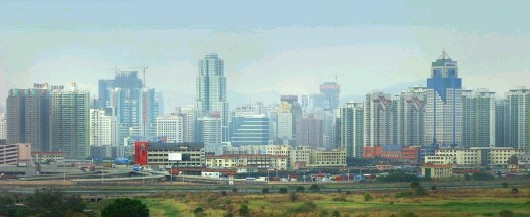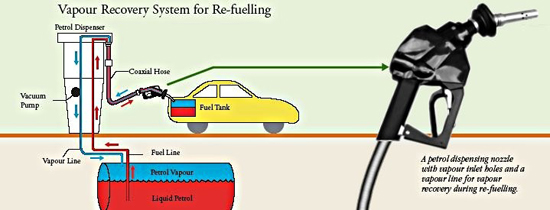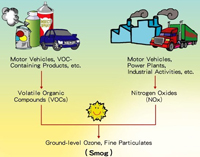Where can I get information about the air quality outside?
What has the Government done to reduce VOC emissions and smog?
How is VOC emission from petrol filling station being controlled?
What will the Government do to further reduce VOC emissions?
How can I help reduce emission of VOCs to the air?
Any guidelines on how I can help reduce VOC emissions?
What are VOCs?
VOCs mean volatile organic compounds and are found in a wide variety of products such as solvent-based paints, printing inks, many consumer products, organic solvents and petroleum products. Motor vehicles and vessels also emit VOCs that eventually cause air pollution and smog.
How do VOCs cause smog?
VOCs play a significant role in the formation of ozone and fine particulates in the atmosphere. Under sunlight, VOCs react with nitrogen oxides emitted mainly from vehicles, power plants and industrial activities to form ozone, which in turn helps the formation of fine particulates. The accumulation of ozone, fine particulates and other gaseous pollutants results in smog that reduces visibility. The economic growth in the Pearl River Delta comes with increased formation of these pollutants, thus aggravating the regional smog phenomenon. Smog is particularly severe under strong sunlight and stagnant weather conditions, e.g. a typhoon approaching, or northerly winds that are common in autumn.

Hong Kong's air quality is under pressure from rapid urban development in the Pearl River Delta region
How does smog affect us?
Smog can irritate our eyes, nose and throat, or can worsen existing heart and respiratory problems such as asthma. People with heart and lung problems, the elderly and children whose respiratory systems are still developing are most at risk. Healthy adults of all ages who exercise or work vigorously outdoor are more sensitive to the pollution because of their higher level of exposure than people who are less active outdoors. Prolonged exposure to severe smog condition may cause permanent damage to lung tissue and affect our immune system. In addition, smog impairs visibility and has a negative impact on tourism.
Where can I get information about the air quality outside?
AQHI (Air Quality Health Index) reported by the EPD tells you the latest and forecast of the short-term health risk of air pollution. More information is given in the AQHI website.

What has the Government done to reduce VOC emissions and smog?
To tackle the regional smog problem, the Government has implemented a wide range of measures to reduce VOC emissions including:
- Controlling emissions from motor vehicles, industrial and commercial processes, and VOC containing products.
-
Working with the Guangdong Provincial Government to set targets to jointly reduce VOC emissions in the Pearl River Delta region.
To achieve the VOC reduction targets, the HKSAR Government has implemented the following control measures:
- Introduced a regulation under Air Pollution Control Ordinance (APCO) in April 1999 to require recovery of petrol vapour released during petrol unloading at petrol filling stations and amended the regulation in March 2005 to extend the recovery to vehicle refuelling.

- Tightened emissions standards of motor vehicles in line with the European Union.
-
Implemented VOC Regulation in phases since 1 April 2007 to control the VOC content in architectural paints/coatings, printing inks and six selected consumer products (i.e. air fresheners, hairsprays, multi-purpose lubricants, floor wax strippers, insecticides and aerosol insect repellents), and require emission reduction devices to be installed on certain printing machines. The regulation was amended in 2009 to extend the control in phases starting from 1 January 2010 to vehicle refinishing paints/coatings, vessel and pleasure craft paints/coatings, adhesives and sealants. In 2017, the regulation was further amended to cover fountain solutions and printing machine cleaning agents with effect from 1 January 2018.
What will the Government do to further reduce VOC emissions?
The Government will consider implementing further measures to control other VOC-containing products which are not being controlled by the Regulation.
How can I help reduce emission of VOCs to the air?
- Avoid using aerosol consumer products such as hairsprays, air fresheners, deodorants, and insecticides that often use VOCs as their propellants. Non-aerosol consumer products are usually in pump, solid, liquid, gel, or roll-on forms.
- Replace solvent-based paints with water-based paints. If solvent-based products cannot be avoided, apply them with hand brushes or rollers instead of sprayers to reduce the use of thinners (which are almost 100% VOCs). This also minimizes overspray and wastage. See also A Simple Guide for Architects, Home Owners and Painters to Reduce Paint VOC Emission(Text Alternative)
 .
. - Avoid using VOC-containing products such as organic cleaning solvents.
- Store VOC-containing products in air-tight containers.
- Buy products with less packaging as the printing of packaging materials generates VOCs.
- Drive less, share rides and use public transportation.
Any guidelines on how I can help reduce VOC emissions?
Yes. You may download and follow some simple guidelines in the leaflets and video below:
A Simple Guide for Architects, Home Owners and Painters to Reduce Paint VOC Emission(Text Alternative) 
A Simple Guide for Publishers and Printers to Reduce VOC Emission (Text Alternative) 
Volatile Organic Compounds and Smog (Text Alternative)
Protect our Blue Sky Limit VOC Emission - For General Public (Text Alternative)
Protect our Blue Sky Limit VOC Emission - For Trade Professionals
Volatile Organic Compounds and You - For Hair Salon / Stylist
Reduce VOC Emission From Adhesives and Sealants(Text Alternative)
Demonstration for using low VOC and waterbased vehicle refinishing paints (Chinese version only)(Text Alternative)

